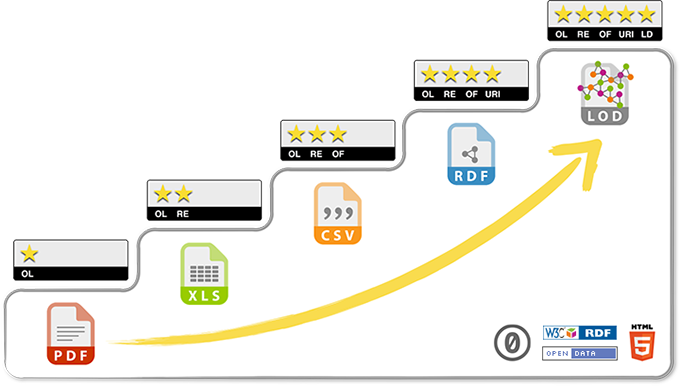5 ★ Open Data
Tim Berners-Lee, the inventor of the Web and Linked Data initiator, suggested a 5-star deployment scheme for Open Data. Here, we give examples for each step of the stars and explain costs and benefits that come along with it.

Tim Berners-Lee, the inventor of the Web and Linked Data initiator, suggested a 5-star deployment scheme for Open Data. Here, we give examples for each step of the stars and explain costs and benefits that come along with it.

Below, we provide examples for each level of Tim’s 5-star Open Data plan. The example data used throughout is ‘the temperature forecast for Galway, Ireland for the next 3 days’:
As a consumer …
As a publisher …
“It’s great to have the data accessible on the Web under an open license (such as PDDL, ODC-by or CC0), however, the data is locked-up in a document. Other than writing a custom scraper, it’s hard to get the data out of the document.”
As a consumer, you can do all what you can do with ★ Web data and additionally:
As a publisher …
“Splendid! The data is accessible on the Web in a structured way (that is, machine-readable), however, the data is still locked-up in a document. To get the data out of the document you depend on proprietary software.”
As a consumer, you can do all what you can do with ★★ Web data and additionally:
As a publisher …
“Excellent! The data is not only available via the Web but now everyone can use the data easily. On the other hand, it’s still data on the Web and not data in the Web.”
As a consumer, you can do all what you can do with ★★★ Web data and additionally:
As a publisher …
“Wonderful! Now it’s data in the Web. The (most important) data items have a URI and can be shared on the Web. A native way to represent the data is using RDF, however other formats such as Atom can be converted/mapped, if required.”
As a consumer, you can do all what you can do with ★★★★ Web data and additionally:
As a publisher …
“Brilliant! Now it’s data, in the Web linked to other data. Both the consumer and the publisher benefit from the network effect.”
Kudos to Andy Seaborne for pointing out the CSV bug, to Kerstin Forsberg for suggesting the ‘data highlighting’ in the four- and five-star examples, as well as to Vassilios Peristeras for proposing to explain not only the ‘what’ but also the ‘why’. Thanks to Egon Willighagen for providing more details about benefits of one-star data. Additional contributions from Christopher Gutteridge. The background picture of Tim Berners-Lee was taken by Paul Clarke and licensed under the Creative Commons Attribution-Share Alike 4.0 International license. This site was originally brought to you by the EC FP7 Support Action LOD-Around-The-Clock (LATC), and now brought to you independently by James G. Kim and Michael Hausenblas.